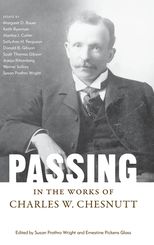Passing in the Works of Charles W. Chesnutt
Passing in the Works of Charles W. Chesnutt
Cite
Abstract
This is a book that reevaluates Charles W. Chesnutt’s deft manipulation of the “passing” theme to expand understanding of the author’s fiction and nonfiction. Nine chapters apply a variety of theories—including intertextual, signifying/discourse analysis, narratological, formal, psychoanalytical, new historical, reader response, and performative frameworks—to add richness to readings of Chesnutt’s works. Together the chapters provide convincing evidence that “passing” is an intricate, essential part of Chesnutt’s writing, and that it appears in all the genres he wielded: journal entries, speeches, essays, and short and long fiction. The chapters engage with each other to display the continuum in Chesnutt’s thinking as he began his writing career and established his sense of social activism, as evidenced in his early journal entries. Collectively, the chapters follow Chesnutt’s works as he proceeded through the Jim Crow era, honing his ability to manipulate his mostly white audience through the astute, though apparently self-effacing, narrator, Uncle Julius, of his popular conjure tales. Chesnutt’s ability to subvert audience expectations is equally noticeable in the subtle irony of his short stories. Several of the book’s chapters address Chesnutt’s novels, including Paul Marchand, F.M.C.; Mandy Oxendine; The House Behind the Cedars; and Evelyn’s Husband. The volume opens up new paths of inquiry into a major African American writer’s oeuvre.
-
Front Matter
-
Charles W. Chesnutt’s Historical Imagination
Werner Sollors
-
Signifying the Other: Chesnutt’s “Methods of Teaching”
SallyAnn H. Ferguson
-
On Flags and Fraternities: Lessons in History in Charles Chesnutt’s “Po’Sandy”
Margaret D. Bauer
-
Passing as Narrative and Textual Strategy in Charles Chesnutt’s “The Passing of Grandison”
Martha J. Cutter
-
The Dream of History: Memory and the Unconscious in Charles Chesnutt’s The House behind the Cedars
Aaron Ritzenberg
-
In the Wake of D. W. Griffith’s The Birth of a Nation: Chesnutt’s Paul Marchand, F.M.C. as Command Performance
Susan Prothro Wright
-
Performing Race: Mixed-Race Characters in the Novels of Charles Chesnutt
Keith Byerman
-
A Question of Passing or a Question of Conscience: Toward Resolving the Ending of Mandy Oxendine
Donald B. Gibson
-
“They Were All Colored to the Life”: Historicizing “Whiteness” in Evelyn’s Husband
Scott Thomas Gibson
-
End Matter
Sign in
Personal account
- Sign in with email/username & password
- Get email alerts
- Save searches
- Purchase content
- Activate your purchase/trial code
Institutional access
-
Sign in through your institution
- Sign in with a library card Sign in with username/password Recommend to your librarian
Institutional account management
Sign in as administratorPurchase
Our books are available by subscription or purchase to libraries and institutions.
Purchasing information| Month: | Total Views: |
|---|---|
| October 2022 | 1 |
| November 2022 | 3 |
| November 2022 | 3 |
| November 2022 | 3 |
| December 2023 | 1 |
| March 2024 | 4 |
| March 2024 | 1 |



Get help with access
Institutional access
Access to content on Oxford Academic is often provided through institutional subscriptions and purchases. If you are a member of an institution with an active account, you may be able to access content in one of the following ways:
IP based access
Typically, access is provided across an institutional network to a range of IP addresses. This authentication occurs automatically, and it is not possible to sign out of an IP authenticated account.
Sign in through your institution
Choose this option to get remote access when outside your institution. Shibboleth/Open Athens technology is used to provide single sign-on between your institution’s website and Oxford Academic.
If your institution is not listed or you cannot sign in to your institution’s website, please contact your librarian or administrator.
Sign in with a library card
Enter your library card number to sign in. If you cannot sign in, please contact your librarian.
Society Members
Society member access to a journal is achieved in one of the following ways:
Sign in through society site
Many societies offer single sign-on between the society website and Oxford Academic. If you see ‘Sign in through society site’ in the sign in pane within a journal:
If you do not have a society account or have forgotten your username or password, please contact your society.
Sign in using a personal account
Some societies use Oxford Academic personal accounts to provide access to their members. See below.
Personal account
A personal account can be used to get email alerts, save searches, purchase content, and activate subscriptions.
Some societies use Oxford Academic personal accounts to provide access to their members.
Viewing your signed in accounts
Click the account icon in the top right to:
Signed in but can't access content
Oxford Academic is home to a wide variety of products. The institutional subscription may not cover the content that you are trying to access. If you believe you should have access to that content, please contact your librarian.
Institutional account management
For librarians and administrators, your personal account also provides access to institutional account management. Here you will find options to view and activate subscriptions, manage institutional settings and access options, access usage statistics, and more.